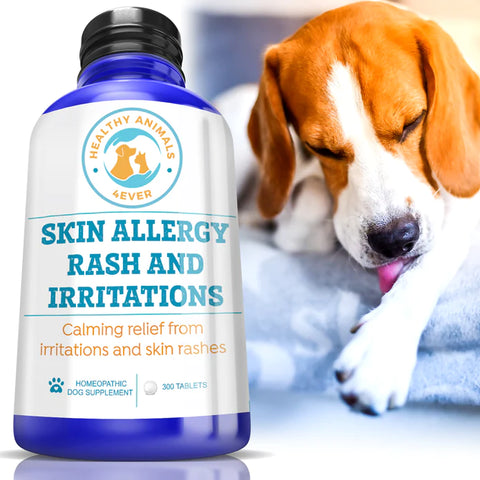Natural Strategies for Managing Mange

Mange is a skin condition that affects animals, commonly dogs and cats, but it can also occur in other mammals, including humans. It's caused by various microscopic mites that infest the skin, leading to a range of symptoms and discomfort for the affected animal. Understanding mange is crucial for pet owners to recognize the signs early and seek appropriate treatment.
Mange Causes
At the heart of mange lies a tiny yet formidable adversary: the mite. These minuscule arachnids, invisible to the naked eye, infiltrate the skin of animals and set the stage for the development of mange. The two primary types of mites responsible for mange in pets are Sarcoptes scabiei and Demodex spp.
Mange Relief. Natural mange remedy for dogs. It works as a supportive and preventative product to maintain ongoing wellness in your pet. Helps with itchiness, scabs, crustiness, inflammation, redness, and hair loss caused by skin mites.
- Sarcoptic mange, also known as scabies, is caused by Sarcoptes scabiei mites. These highly contagious parasites burrow into the skin, triggering intense itching and discomfort. Transmission occurs through direct contact with an infected animal, making it particularly rampant in environments with close animal proximity.
- Demodectic mange, caused by Demodex mites, is a bit more complex. These mites are commonly present in small numbers on healthy animal skin. However, under certain conditions, such as a compromised immune system or genetic predisposition, Demodex populations can increase, leading to skin irritation and hair loss.
It can affect both cats and dogs, although the specific types of mites and the manifestations of the condition may vary between the two species.
In Dogs…
Sarcoptic mange in dogs, also known as scabies, is highly contagious and characterized by intense itching, hair loss, and red, inflamed skin. Dogs with sarcoptic mange may develop crusty lesions around the ears, elbows, and abdomen.
Transmission occurs through direct contact with an infected animal or contaminated environment.

Demodectic mange in dogs, also called demodicosis or "red mange," is caused by Demodex mites, ordinarily present in small numbers on healthy dogs. In dogs with weakened immune systems or genetic predispositions, Demodex populations can increase, leading to hair loss, redness, and scaly skin.
Demodectic mange is not contagious between dogs.
In Cats…
In cats, the most common type of mange is caused by ear mites (Otodectes cynotis), which infest the ears rather than the skin. However, cats can also develop other forms of mange, including notoedric mange.
Notoedric mange, caused by Notoedres cati mites, is similar to sarcoptic mange in dogs and is highly contagious. Cats with notoedric mange may exhibit intense itching, hair loss, crusty lesions, and red, inflamed skin, particularly on the head, neck, and ears.
Contributing Factors
While mites play a central role in mange development, several contributing factors can exacerbate the condition or increase susceptibility:
- Poor hygiene and sanitation create an environment conducive to mite infestation.
- Stress and weakened immune function make pets more vulnerable to mite proliferation.
- Genetic predisposition, with certain breeds exhibiting higher susceptibility to specific types of mange.
- Environmental factors, such as overcrowding and inadequate living conditions, facilitate mite transmission and spread.
Skin allergy, rashes, and irritations is natural allergy remedy for all cats. It helps heal irritated & infected skin. It may provide relief from insect bites. Provides a calming effect. All-natural formula. Easy to use.
Mange Symptoms
Early recognition of mange symptoms is crucial for timely intervention and effective treatment. Let's explore the subtle yet telling signs that may indicate your pet is grappling with mange.
1. Itchy PredicamentOne of the hallmark symptoms of mange is relentless itching. Affected pets often exhibit intense scratching, biting, and licking to alleviate the discomfort caused by mite infestation. It could be a red flag for mange if you notice your pet obsessively scratching or rubbing against furniture and surfaces.
2. Hair-raising Hair LossMange-induced hair loss can manifest in various patterns, from localized bald patches to widespread shedding. Areas commonly affected include the face, ears, elbows, and abdomen. Keep an eye out for unusual bald spots or thinning fur, as these may indicate an underlying issue such as mange.
3. Red Flags on the SkinRedness, inflammation, or irritation on your pet's skin warrants closer inspection. Mange can cause the skin to become inflamed, crusty, or scaly, particularly in areas where mites have burrowed beneath the surface. Check for signs of redness or rash-like lesions, especially in regions prone to mite infestation.

While some signs of mange are visible to the naked eye, others lurk beneath the surface. Secondary bacterial infections, a common complication of mange, can exacerbate symptoms and prolong discomfort for affected pets. Look for signs of skin infection, such as oozing sores, foul odor, or hot spots.
5. Behavioral CluesIn addition to physical symptoms, your pet's behavior changes may signal an underlying issue such as mange. Watch for signs of irritability, restlessness, or reluctance to be touched, as these behavioral changes may indicate discomfort or pain associated with mange.
Mange Diagnosis
Diagnosing mange typically involves a combination of physical examination, skin scrapings, and other diagnostic tests conducted by a veterinarian.
- The veterinarian will begin by examining the pet's skin and fur for characteristic signs of mange, such as hair loss, redness, inflammation, crusty lesions, or scaly patches. They will also assess the pet's overall health and accompanying symptoms, such as itching or discomfort.
- To confirm the presence of mites, the veterinarian may perform a skin scraping procedure. During this procedure, a small sample of skin cells and debris is collected from the affected areas using a scalpel blade or a specialized tool. The sample is then examined under a microscope to detect the presence of mites, their eggs, or fecal matter.
- The collected skin scrapings are examined under a microscope to identify the type of mites present. Specific species of mites cause different types of mange, so identifying the mite species is essential for determining the appropriate treatment approach.
Skin allergy, rash, and irritations is natural allergy remedy for all dogs. It helps heal irritated & infected skin. It may provide relief from insect bites. Provides a calming effect. All-natural formula. Easy to use.
- In some cases, additional tests may be necessary to confirm the diagnosis or evaluate the extent of the condition. These may include skin cultures to identify bacterial or fungal infections, blood tests to assess the pet's overall health and immune function, or allergy testing to rule out underlying allergic reactions.
- In cases where the diagnosis is unclear or the pet does not respond to initial treatment, further diagnostic tests or a treatment trial may be recommended. Monitoring the pet's response to treatment can also help confirm the diagnosis of mange.
Overall, diagnosing mange requires a thorough evaluation by a qualified veterinarian, including a combination of physical examination, skin scrapings, and other diagnostic tests. Once a diagnosis is confirmed, the veterinarian can develop a tailored treatment plan to address the specific type of mange and promote the pet's recovery and comfort.
Treatment Options
Dealing with mange can be a daunting challenge for pet owners, but relief is within reach with the proper treatment approach. It's crucial for pet owners to be aware of the existing options.
- Medicated baths are a cornerstone of mange treatment, offering targeted relief by directly addressing mite infestations and soothing irritated skin. Specialized shampoos containing benzoyl peroxide, sulfur, or medicated cleansers are often prescribed to kill mites and alleviate itching. Regular bathing routines can help control mite populations and promote healing of affected skin.
- In addition to medicated baths, topical treatments such as creams or ointments may be recommended to target localized mange lesions and provide targeted relief. These topical treatments are often used with other therapeutic approaches for comprehensive mange management.

- For more severe cases of mange or widespread mite infestations, oral medications may be prescribed to tackle the problem from the inside out. Oral medications are typically administered under veterinary supervision to ensure safety and efficacy.
- In cases where secondary bacterial infections have developed due to mange-induced skin irritation, antibiotics may be necessary to combat the infection and prevent further complications. Oral or topical antibiotics may be prescribed to target bacterial overgrowth and promote the healing of damaged skin. It's important to complete the entire course of antibiotics as your veterinarian directs to ensure effective treatment.
- In addition to direct treatment of the affected pet, environmental management plays a crucial role in mange control. Thorough cleaning and disinfection of living areas, bedding, and grooming tools can help prevent reinfestation and halt the spread of mites. Regular vacuuming, washing of pet bedding, and sanitization of common surfaces can significantly reduce mite populations and support recovery.
Mange Prevention
Preventing mange in your pet involves a multifaceted approach that combines good hygiene practices, environmental management, and natural remedies. By implementing proactive strategies, pet owners can reduce the risk of mange infestations and promote overall skin health.
1. Hygiene HabitsRegular bathing and grooming are essential for maintaining your pet's skin health and warding off mange. Use gentle, pet-safe shampoos formulated to cleanse the skin without stripping away natural oils. Pay close attention to areas prone to mite infestation, such as the ears, face, and abdomen, and thoroughly dry your pet after bathing to prevent moisture buildup.
2. Environmental ManagementKeeping your pet's environment clean and sanitary is crucial for mange prevention. Wash pet bedding regularly in hot water to kill mites, remove allergens, and vacuum floors and furniture to eliminate mite eggs and larvae. Minimize exposure to potential sources of contamination, such as stray animals or heavily infested areas, to reduce the risk of mite transmission.
3. Dietary SupportAll digestive is natural digestive support for cats. It helps with stomach upset, diarrhea, and gastritis and aids in restoring digestive balance and your pet's comfort. All-natural formula. Easy to use.
Ensure your pet receives a balanced diet that provides all the essential nutrients, vitamins, and minerals for optimal health. A diet of high-quality protein sources, healthy fats, complex carbohydrates, vitamins, and minerals is essential for supporting the immune system and promoting skin health.
- Omega-3 fatty acids, found in fish oil supplements or certain foods like salmon, flaxseeds, and chia seeds, have anti-inflammatory properties that can help reduce inflammation and itching associated with mange. Adding omega-3 fatty acids to your pet's diet may help improve skin condition and support healing.
- Probiotics are beneficial bacteria that support gut health and immune function. Maintaining a healthy gut flora balance can help strengthen the immune system and improve the body's ability to fight off infections, including mange. Consider adding probiotic supplements or probiotic-rich foods like yogurt or kefir to your pet's diet.
- Antioxidant-rich foods such as fruits and vegetables (e.g., blueberries, carrots, spinach) can help neutralize free radicals and reduce oxidative stress, which may contribute to skin inflammation and damage. Including various antioxidant-rich foods in your pet's diet can help support overall health and skin function.
- Adequate hydration is essential for maintaining healthy skin and supporting the body's natural healing processes. Ensure your pet has access to clean, fresh water at all times, and consider incorporating moisture-rich foods like canned or wet food into their diet to help maintain hydration levels.
- Some pets may have food sensitivities or allergies that can exacerbate skin conditions like mange. Monitor your pet's diet closely and consider eliminating potential trigger foods if you suspect they may contribute to their symptoms. Common allergens include grains, dairy, and specific proteins.
Several herbal remedies boast natural antiparasitic and anti-inflammatory properties that can complement conventional mange treatments. Dilute essential oils with a carrier oil and apply topically to affected areas, or add herbal extracts to your pet's bath water for relief.
While herbal remedies may offer some relief for mange symptoms and support the skin's healing process, it's important to note that they should be used as complementary treatments alongside veterinary care.
- Neem oil is derived from the neem tree and has natural antiparasitic, antibacterial, and anti-inflammatory properties. It can help soothe irritated skin, reduce itching, and inhibit the growth of mites. Dilute neem oil with a carrier oil such as coconut oil and apply it topically to affected areas.
- Tea tree oil is known for its antimicrobial and anti-inflammatory properties, making it a popular remedy for skin conditions like mange. However, tea tree oil should be used cautiously as it can be toxic to pets if ingested in large quantities. Dilute tea tree oil with a carrier oil and apply it sparingly to affected areas.
- Aloe vera has soothing and cooling properties that can help relieve itching, reduce inflammation, and promote the healing of damaged skin. Apply aloe vera gel directly from the plant or use a pet-safe aloe vera gel to affected areas.

- Calendula, also known as marigold, has anti-inflammatory and wound-healing properties that can benefit pets with mange. Calendula cream or ointment can be applied topically to soothe irritated skin and promote healing.
- Chamomile has anti-inflammatory and calming properties that can help reduce itching and inflammation associated with mange. You can brew chamomile tea and use it as a soothing rinse or apply chamomile-infused water directly to affected areas.
- Turmeric contains curcumin, a compound with anti-inflammatory and antioxidant properties that can help reduce inflammation and support skin healing. You can add turmeric powder to your pet's food or create a paste by mixing it with water and applying it topically to affected areas.
Homeopathy for Mange
Homeopathic remedies for mange aim to address the underlying imbalances in the body and support the pet's immune system in fighting off mite infestations. While homeopathy is not a substitute for conventional veterinary care, it can be used as a complementary approach to mange treatment.
Sulfur is often prescribed for pets with skin conditions, including mange, with intense itching, redness, and burning sensations. It may help reduce inflammation, promote healing, and alleviate discomfort associated with mange.
Mange Relief. Natural mange remedy for cats. It works as a supportive and preventative product to maintain ongoing wellness in your pet. Helps with itchiness, scabs, crustiness, inflammation, redness, and hair loss caused by skin mites.
Arsenicum album is indicated for pets with mange who experience intense itching and burning, particularly at night. Pets may also exhibit restlessness, anxiety, and a desire for warmth. Arsenicum album may help soothe irritated skin and alleviate symptoms associated with mange.
Psorinum is often prescribed for pets with chronic mange that fails to respond to conventional treatments. Pets may have foul-smelling discharge, thick crusts, and intense itching. Psorinum may help stimulate the immune system and address underlying imbalances that contribute to mange.
It's important to consult with a qualified homeopathic veterinarian for proper evaluation and individualized treatment recommendations for your pet. Homeopathic remedies should be used under the guidance of a trained professional and as part of a comprehensive mange management plan that may also include conventional treatments and supportive care.
The Bottom Line
Mange is a common and treatable condition in pets, but early detection and prompt intervention are crucial for successful treatment. By understanding the causes, recognizing the symptoms, and exploring available treatment options, pet owners can effectively manage mange, and improve their pet's quality of life.














